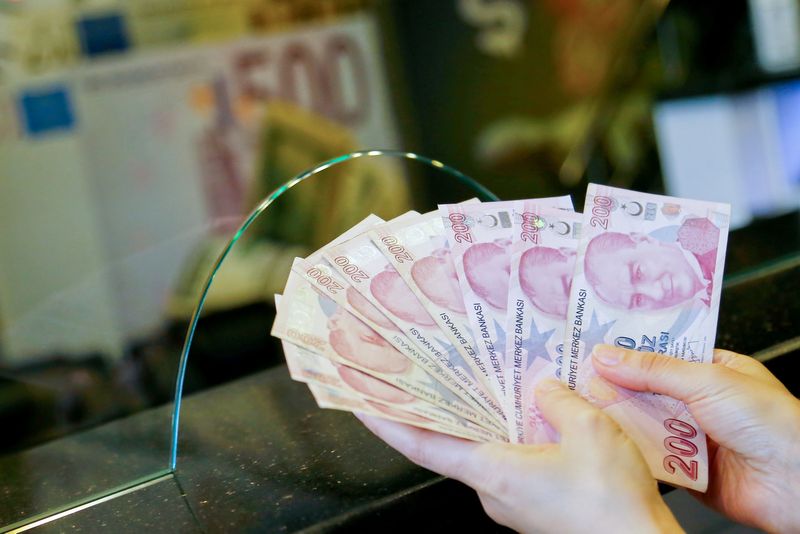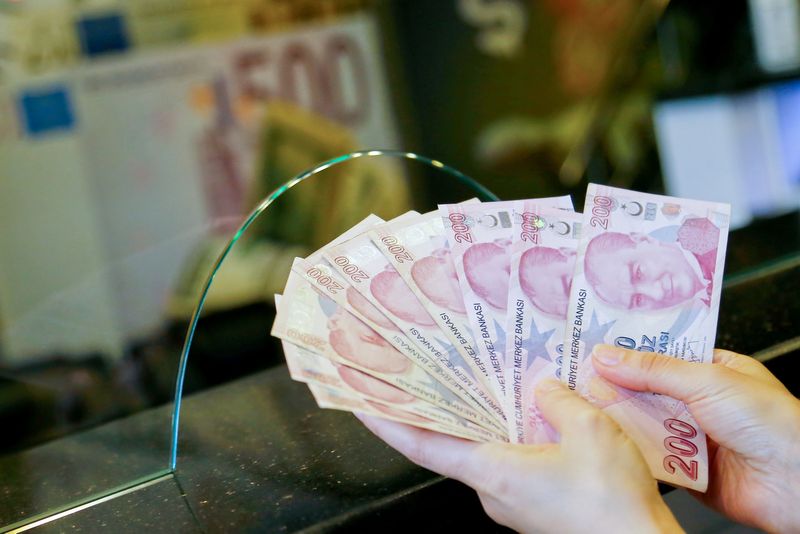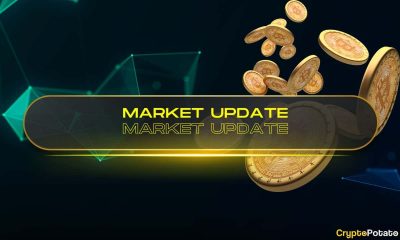Economy
Analysis-After Turkey’s giant rate hike, foreign investors mull return


© Reuters. A money changer holds Turkish lira banknotes at a currency exchange office in Ankara, Turkey September 27, 2021. REUTERS/Cagla Gurdogan
By Nevzat Devranoglu and Karin Strohecker
ANKARA/LONDON (Reuters) – Turkey’s latest massive interest rate hike has caught the attention of long-sceptical foreign investors who say they could return to Turkish assets if authorities continue to demonstrate that a return to orthodox monetary policy is underway.
The lira rallied as much as 7% on Thursday after the central bank shocked the market by lifting its key rate by 750 basis points to 25% – three times the size of the expected move.
Turkey’s top officials say that they plan to take two more vital steps to reverse a years-long exodus of foreign investment as well: they will publish a comprehensive economic programme next month that will reduce uncertainties; and they will begin holding meetings with investors abroad.
Finance Minister Mehmet Simsek will kick off the investor roadshow on Sept. 19 at Goldman Sachs headquarters in New York, Reuters reported on Friday.
Though the tide may be shifting, persuading investors will not be easy: Foreigners had all but abandoned Turkey over the last five years of President Tayyip Erdogan’s unorthodox and often erratic policies, which included slashing interest rates in the face of soaring inflation.
Yet five foreign investors told Reuters that this week’s rate hike signalled a new independence among policymakers who are serious about addressing unrelenting pressure on the currency and reining in inflation expectations.
“It feels like they are correcting the mistakes they made with their first rate hike decisions,” said Viktor Szabo, portfolio manager at abrdn in London. “And it is a sign that the pressure continued on the currency.”
Ola El-Shawarby, deputy portfolio manager for Emerging Markets Equity Strategy at Van Eck, said: “We have some exposure and we are getting more comfortable with the overall picture so we are getting more constructive.”
“The more proof we get of the return to orthodoxy the more likely we are to revisit these investments,” she said.
ERDOGAN QUESTION
Faced with badly depleted FX reserves and other economic strains, Erdogan, fresh from winning re-election in May, appointed Simsek and picked as central bank governor former Wall Street banker Hafize Gaye Erkan – the first woman to run the central bank – to turn things around.
Vice President Cevdet Yilmaz told bankers that next month’s “medium-term programme” will detail a transition to increased economic and financial predictability and include three-year macro forecasts. The investor roadshow will also accelerate, he added.
Simsek has stressed his team has political support for its plan, which should see inflation begin to cool around May of next year.
Erdogan, who has fired four central bank chiefs in four years, has said little about the rate hikes.
“They will have to raise policy rates further in this cycle to have a lasting effect on international investors,” said Blaise Antin, head of EM sovereign research at asset manager TCW in Los Angeles.
“The question is whether they have Erdogan’s green light to keep going.”
The central bank said on Thursday it will hike rates more as needed and JPMorgan (NYSE:) predicted they will hit 35% by year-end.
TENTATIVE STEPS
With inflation seen rising to near 60% by the end of the year from almost 48% last month, the rate hikes partly narrow the gap.
Though Turkey’s international bonds are widely held and form part of key indexes, the country has struggled to lure foreign investors back into its domestic bond markets after a series of lira crises and de facto capital controls.
Foreigners hold less than 1% of Turkish bonds, down from 10% in 2019 and 20% in 2015, official data shows. Over the last three months, bonds saw only $110.5 million in cumulative foreign inflows, while stocks saw a rush of $1.7 billion.
Turkish stock, Eurobond and CDS markets are more attractive targets this year and next, especially after the rate hike, investors and officials say. New investments from Gulf states have helped to buy time and refresh FX reserves.
“Ultimately for investors the end rate matters – but it is more that the central bank is ready to act when needed,” said Kaan Nazli, portfolio manager at asset manager Neuberger Berman in London. “But seeing that change is a positive thing.”
Aside from the combined 1,650 basis points in monetary tightening since June, there are other signs of lasting change. Authorities have raised taxes to limit budget deficits, cooled domestic demand, begun rolling back a costly depreciation-protected deposit scheme, and raised FX reserves by $20 billion to head off any possible current account deficit crisis.
In an interview with newspaper Yeni Safak, Simsek said Turkey held huge promise for foreign investors as long as “we follow rules-based policies in line with world norms.”
After meetings in New York and at the United Nations – which Erdogan is also expected to attend – Simsek listed plans for trips to London and an International Monetary Fund event in Morocco, as well as other meetings in Japan, Singapore and Hong Kong by the end of the year.
Economy
Russian central bank says it needs months to make sure CPI falling before rate cuts -RBC


© Reuters. Russian Central Bank Governor Elvira Nabiullina attends a news conference in Moscow, Russia June 14, 2019. REUTERS/Shamil Zhumatov/File Photo
MOSCOW (Reuters) – Russia’s central bank will need two to three months to make sure that inflation is steadily declining before taking any decision on interest rate cuts, the bank’s governor Elvira Nabiullina told RBC media on Sunday.
The central bank raised its key interest rate by 100 basis points to 16% earlier in December, hiking for the fifth consecutive meeting in response to stubborn inflation, and suggested that its tightening cycle was nearly over.
Nabiullina said it was not yet clear when exactly the regulator would start cutting rates, however.
“We really need to make sure that inflation is steadily decreasing, that these are not one-off factors that can affect the rate of price growth in a particular month,” she said.
Nabiullina said the bank was taking into account a wide range of indicators but primarily those that “characterize the stability of inflation”.
“This will take two or three months or more – it depends on how much the wide range of indicators that characterize sustainable inflation declines,” she said.
The bank will next convene to set its benchmark rate on Feb. 16.
The governor also said the bank should have started monetary policy tightening earlier than in July, when it embarked on the rate-hiking cycle.
Economy
China identifies second set of projects in $140 billion spending plan


© Reuters. FILE PHOTO: Workers walk past an under-construction area with completed office towers in the background, in Shenzhen’s Qianhai new district, Guangdong province, China August 25, 2023. REUTERS/David Kirton/File Photo
SHANGHAI (Reuters) – China’s top planning body said on Saturday it had identified a second batch of public investment projects, including flood control and disaster relief programmes, under a bond issuance and investment plan announced in October to boost the economy.
With the latest tranche, China has now earmarked more than 800 billion yuan of its 1 trillion yuan ($140 billion) in additional government bond issuance in the fourth quarter, as it focuses on fiscal steps to shore up the flagging economy.
The National Development and Reform Commission (NDRC) said in a statement on Saturday it had identified 9,600 projects with planned investment of more than 560 billion yuan.
China’s economy, the world’s second largest, is struggling to regain its footing post-COVID-19 as policymakers grapple with tepid consumer demand, weak exports, falling foreign investment and a deepening real estate crisis.
The 1 trillion yuan in additional bond issuance will widen China’s 2023 budget deficit ratio to around 3.8 percent from 3 percent, the state-run Xinhua news agency has said.
“Construction of the projects will improve China’s flood control system, emergency response mechanism and disaster relief capabilities, and better protect people’s lives and property, so it is very significant,” the NDRC said.
The agency said it will coordinate with other government bodies to make sure that funds are allocated speedily for investment and that high standards of quality are maintained in project construction.
($1 = 7.1315 renminbi)
Economy
Russian central bank says it needs months to make sure CPI falling before rate cuts -RBC


© Reuters. Russian Central Bank Governor Elvira Nabiullina attends a news conference in Moscow, Russia June 14, 2019. REUTERS/Shamil Zhumatov/File Photo
MOSCOW (Reuters) – Russia’s central bank will need two to three months to make sure that inflation is steadily declining before taking any decision on interest rate cuts, the bank’s governor Elvira Nabiullina told RBC media on Sunday.
The central bank raised its key interest rate by 100 basis points to 16% earlier in December, hiking for the fifth consecutive meeting in response to stubborn inflation, and suggested that its tightening cycle was nearly over.
Nabiullina said it was not yet clear when exactly the regulator would start cutting rates, however.
“We really need to make sure that inflation is steadily decreasing, that these are not one-off factors that can affect the rate of price growth in a particular month,” she said.
Nabiullina said the bank was taking into account a wide range of indicators but primarily those that “characterize the stability of inflation”.
“This will take two or three months or more – it depends on how much the wide range of indicators that characterize sustainable inflation declines,” she said.
The bank will next convene to set its benchmark rate on Feb. 16.
The governor also said the bank should have started monetary policy tightening earlier than in July, when it embarked on the rate-hiking cycle.

 Forex2 years ago
Forex2 years agoForex Today: the dollar is gaining strength amid gloomy sentiment at the start of the Fed’s week

 Forex2 years ago
Forex2 years agoHow is the Australian dollar doing today?

 Forex1 year ago
Forex1 year agoUnbiased review of Pocket Option broker

 Forex2 years ago
Forex2 years agoDollar to pound sterling exchange rate today: Pound plummeted to its lowest since 1985

 Cryptocurrency2 years ago
Cryptocurrency2 years agoWhat happened in the crypto market – current events today

 World2 years ago
World2 years agoWhy are modern video games an art form?

 Stock Markets2 years ago
Stock Markets2 years agoMorgan Stanley: bear market rally to continue

 Economy2 years ago
Economy2 years agoCrude oil tankers double in price due to EU anti-Russian sanctions

































